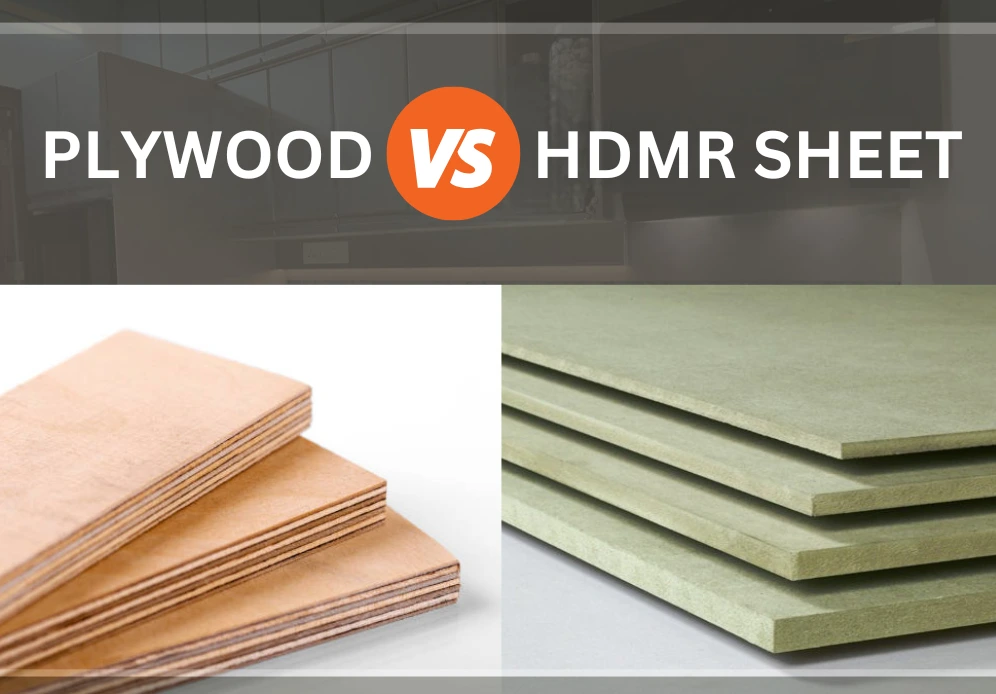When choosing materials for furniture or construction, let’s understand the differences between HDMR sheet Vs Plywood which is crucial. Both of these materials are popular in interior design and construction, but they serve different purposes. Whether you’re a homeowner, contractor, or designer, knowing which material suits your needs can save time and money.
What Is HDMR?
HDMR stands for High-Density Moisture Resistant board. It’s a new-generation material that offers superior durability and resistance to moisture. These sheets are made by compressing wood fibers and combining them with resins under high pressure and temperature.
This process creates a dense, strong, and moisture-resistant board. HDMR is commonly used in kitchen cabinets, wardrobes, and other furniture where moisture resistance is crucial.
What Is Plywood?
Plywood is a well-known material used in construction and furniture making. It consists of thin layers of wood veneers glued together with the grains of adjacent layers at right angles. This cross-graining provides plywood with its strength and stability. Plywood comes in various grades, thicknesses, and types, making it versatile for different applications.
HDMR Sheet vs Plywood: Key Differences
Understanding the key differences between HDMR sheets vs plywood can help you decide which material is better for your project. Here’s a closer look at these differences:
1. Moisture Resistance
When it comes to moisture resistance, HDMR sheets have a clear advantage over plywood. Moisture resistant sheets are specifically designed to withstand moisture, making them ideal for use in areas like kitchens, bathrooms, and humid environments.
Plywood, while available in moisture-resistant grades like marine plywood, can still swell or warp over time if exposed to excessive moisture.
2. Strength and Durability
Both HDMR sheets and plywood are strong, but their strength differs based on their construction. HDMR sheets are denser and more uniform in structure, giving them excellent strength and durability.
Plywood, with its cross-layered structure, is also strong and can handle significant load-bearing applications. However, plywood’s strength can vary depending on the grade and type.
3. Surface Finish
The surface finish is another area where HDMR sheets shine. have a smooth, uniform surface that can be painted, laminated, or veneered with ease. This makes them a preferred choice for high-quality furniture where finish is important.
Plywood, on the other hand, may have a rougher surface, depending on the grade. Higher-grade plywood can also be finished beautifully but might require more preparation.
4. Workability
When comparing HDMR sheets vs plywood in terms of workability, plywood tends to be more user-friendly. Plywood can be easily cut, shaped, and drilled, making it a favorite among carpenters and DIY enthusiasts.
while strong, can be harder to work with due to their density. Special tools may be needed to cut and shape HDMR without chipping or damaging the material.
5. Cost
Cost is always a significant factor when choosing materials. Generally, are more expensive than plywood. The higher cost is due to the advanced manufacturing process and superior properties of HDMR sheets.
Plywood, being more readily available in various grades, offers a broader range of prices, making it more accessible for budget-conscious projects.
6. Weight
HDMR sheets are denser and heavier than plywood. This extra weight can make HDMR more challenging to handle during installation.
Plywood, being lighter, is easier to transport and install, especially for larger projects like wall paneling or roofing.
HDMR Sheets vs Plywood: Applications & Uses
Knowing where to use HDMR sheet vs plywood is essential for achieving the best results in your projects. Here’s a guide to their most common applications:
HDMR Sheets
HDMR stands for High-Density Moisture Resistant board. It’s a new-generation material that offers superior durability and resistance to moisture.
- Kitchen Cabinets: The moisture resistance of HDMR makes it ideal for kitchen environments where spills and humidity are common.
- Wardrobes: HDMR sheet are perfect for wardrobes, especially in areas with high humidity.
- Bathroom Furniture: Given its moisture resistance, HDMR is excellent for bathroom cabinets and storage units.
- Office Furniture: The smooth finish of HDMR makes it suitable for office furniture, offering both durability and aesthetic appeal.
Plywood
Plywood consists of thin layers of wood veneers glued together with the grains of adjacent layers at right angles.
- Wall Paneling: Plywood’s strength and availability in large sheets make it perfect for wall paneling.
- Flooring: Plywood is often used as a subflooring material due to its stability and strength.
- Roofing: Plywood is commonly used in roofing because of its load-bearing capacity.
- Furniture Making: Plywood is versatile and can be used in making various types of furniture, from tables to chairs.
MRS Woodcraft is renowned for supplying the best plywood in India, as it has plywood at a competitive price and durability as its features.
Conclusion
In the debate between HDMR sheet vs plywood, the choice ultimately depends on your specific needs. offer superior moisture resistance, a smooth finish, and durability, making them ideal for environments where these factors are crucial.
Plywood, on the other hand, offers versatility, ease of workability, and a range of cost options, making it suitable for a broader range of applications. Whether you choose HDMR or plywood, understanding their strengths and limitations will help ensure the success of your project.
Frequently Asked Questions
Do HDMR Sheets Last Longer Than Plywood?
In high-humidity environments, HDMR sheets may outlast plywood due to their moisture resistance, but both materials can last for years if properly maintained.
What Are The Main Applications Of HDMR Sheets?
HDMR sheets are commonly used in kitchen cabinets, wardrobes, bathroom furniture, and office furniture due to their durability and moisture resistance.
Can HDMR Sheets Be Used For Outdoor Furniture?
HDMR sheets are not typically recommended for outdoor use unless specifically treated, as they may not withstand extreme weather conditions like specialized outdoor plywood.
Which Is Easier To Work With: HDMR Sheet Vs Plywood?
Plywood is generally easier to work with due to its lighter weight and easier cutting and shaping properties.

